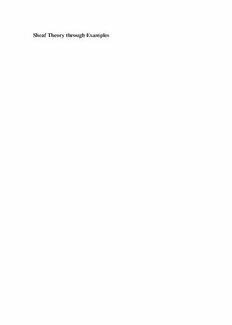
Sheaf Theory Through Examples PDF
Preview Sheaf Theory Through Examples
SheafTheorythroughExamples SheafTheorythroughExamples DanielRosiak TheMITPress Cambridge,Massachusetts London,England ©2022MassachusettsInstituteofTechnology ThisworkissubjecttoaCreativeCommonsCC-BY-NC-NDlicense. Subjecttosuchlicense,allrightsarereserved. TheopenaccesseditionofthisbookwasmadepossiblebygenerousfundingfromArcadia—a charitablefundofLisbetRausingandPeterBaldwin. The MIT Press would like to thank the anonymous peer reviewers who provided comments on drafts of this book. The generous work of academic experts is essential for establishing the authority and quality of our publications. We acknowledge with gratitude the contributions of these otherwise uncredited readers. This book was set in LaTeX by the author. Library of Congress Cataloging-in-Publication Data Names: Rosiak, Daniel, author. Title: Sheaf theory through examples / Daniel Rosiak. Description: Cambridge, Massachusetts : The MIT Press, [2022] | Includes bibliographical references and index. Identifiers: LCCN 2021058949 | ISBN 9780262542159 (paperback) Subjects: LCSH: Sheaf theory. Classification: LCC QA612.36 .R67 2022 | DDC 514/.224–dc23/eng20220521 LC record available at https://lccn.loc.gov/2021058949 ToFernandoZalamea,whoguidedmyearlyforayintosheaves,andwhose encouragementandexamplehelpedmyloveofcategorytheoryflourish. Contents Acknowledgments ix Introduction 1 1 Categories 21 1.1 CategoricalPreliminaries 21 1.2 AFewMoreExamples 35 1.3 ReturningtotheDefinitionandDistinctionsofSize 36 1.4 SomeNewCategoriesfromOld 40 1.5 Asideon“NoObjects” 43 2 PreludetoSheaves:Presheaves 45 2.1 Functors 46 2.2 NaturalTransformations 61 2.3 SeeingStructuresasPresheaves 65 2.4 ThePresheafAction 71 2.5 PhilosophicalPass:TheFourActionPerspectives 85 3 UniversalConstructions 89 3.1 LimitsandColimits 89 3.2 PhilosophicalPass:UniversalityandMediation 104 4 Topology:AFirstPassatSpace 109 4.1 Motivation 109 4.2 ADialogueIntroducingtheKeyNotionsofTopology 111 4.3 TopologyandTopologicalSpacesMoreFormally 123 4.4 PhilosophicalPass:OpenQuestions 144 5 FirstLookatSheaves 147 5.1 Sheaves:TheTopologicalDefinition 147 5.2 Examples 151 5.3 PhilosophicalPass:SheafasLocal-GlobalPassage 168 6 There’saYonedaLemmaforThat 171 6.1 First,Enrichment! 171 6.2 DownsetsandYonedaintheMiniature 175 6.3 RepresentabilitySimplified 179 6.4 MoreonRepresentability,FixedPoints,andaParadox 183 viii Contents 6.5 YonedaintheGeneral 187 6.6 PhilosophicalPass:YonedaandRelationality 190 7 Adjunctions 195 7.1 AdjunctionsthroughMorphology 195 7.2 AdjunctionsthroughModalities 210 7.3 SomeAdditionalAdjunctionsandFinalThoughts 237 7.4 PhilosophicalPass:TheIdeaofAdjointness 239 8 SheavesRevisited 241 8.1 ThreeHistoricallySignificantExamples 241 8.2 WhatIsNotaSheaf? 267 8.3 PresheavesandSheavesinOrderTheory 271 9 CellularSheafCohomologythroughExamples 277 9.1 SimplicesandTheirSheaves 279 9.2 SheafCohomology 292 9.3 PhilosophicalPass:SheafCohomology 305 9.4 AGlimpseintoCosheaves 306 10 SheavesonaSite 311 10.1 RevisitingCovers:TowardGeneralSheaves 311 10.2 GrothendieckToposes 314 10.3 AFewMoreExamples 353 10.4 PhilosophicalPass:TheIdeaofToposes 365 11 ElementaryToposes 369 11.1 TheSubobjectClassifier 370 11.2 ExamplesofElementaryToposes 377 11.3 Lawvere-TierneyTopologiesandTheirSheaves 379 11.4 MorphismsofToposes 394 11.5 TowardCohesiveToposes 400 A Appendix(RevisitingTopology) 411 A.1 ConceptualMotivation:TopologyasLogicofFiniteObservations 412 A.2 ExplicitConnectionstoModalLogic 415 A.3 TheIdeaofAllThis 424 A.4 WhyOpens? 426 A.5 WhatIsTopologyReallyAbout? 429 References 431 Index 439 Acknowledgments I didn’t set out to write a book on sheaves. In 2017, as I was wrapping up my PhD in philosophy, I received a Fulbright grant to work with Fernando Zalamea in Bogotá, the ostensible aim of which was to support the completion of a brief supplementary chapter givingahigh-leveloverviewofcertainphilosophicalelementsofinterestincategorytheory and sheaf theory. While I had already been doing research in category theory for some years,asIcametodevotemoreattentiontosheaftheoryinitsownrightthatyearIbecame entirelyengrossedandfoundmyselfthinkingaboutsheavesalldayeveryday.Bytheend of that year, I found that I had produced over 200 pages of notes on sheaves with novel examples and reflections. A number of mathematicians with whom I shared these early notes found them stimulating and encouraged me to circulate them. While it was never myintentiontowriteabook,manyreadersofthoseearlynotesencouragedmetodevelop them into something more. Over the next four years, as my research led me further into the land of sheaves, and guided by feedback from new readers, I continued to add new examplesandcontenthereandthere,andatsomepointitbecameevidentthatthesewere nolongernotes.Ithadgrownintosomethingclosetothepresentbook. Overtheyears,Ihavetriedtofilloutthestoryinanumberofways.Butonaccountofits somewhat accidental genesis, the book remains necessarily incomplete and my selection ofexamplesandpointsoffocusiscertainlypartial.Ontheotherhand,afteryearsofnew additionsandrevisions,Idohopesomeoftheinitialexcitementofthoseearlynotesstill shinesthrough. Therearemanypeoplewhosefeedbackovertheyearshasgreatlyimprovedthiswork, and many people from whom I have learned an immense amount along the way. Above all, I would like to express my profound gratitude to Fernando Zalamea, without whose support and encouragement, from the earliest stages, this book would never have come to be. Among the colleagues who offered encouragement and/or valuable feedback on various versions of this manuscript, I would like to thank Colin McLarty, Emily Riehl, MichaelRobinson,DavidSpivak,WalterTholen,andPhilippZahn.Iamespeciallygrate- fultoJustinCurryandAlanHylton,whosedetailedcomments,suggestionsforsubstantial improvements to the organization of the manuscript, stimulating discussions, and ongo- ing encouragement helped me get the book over the finish line. Let me also express my indebtednesstoWilliamLawvere,whoseworkhasbeenawellofinspirationformeover theyears;withouthisparticularwisdom,IamsurethatIwouldneverhavecometoaspire to the new knowledge of reality that is thinking categorically. I would also like to thank x Acknowledgments theanonymousreviewersfromMITPressfortheirhelpfulfeedbackandcorrectionsonan earlierversion. IamverygratefultothecontributorstothenLab,forspendingtheirtimeputtingtogether manyimpressivelyrichreflectionsoncategorytheory,sheaves,andevensomephilosophy. Inanagewhenitissoeasytodespairofthemountainsofsuperficialcontentonline,and soeasytofindunrewardingwaysofspendingone’stimelookingatascreen,thankyoufor creatingacorneroftheinternetwithsomethingprofoundandrewarding. Finally, I would like to thank the editors at MIT Press, Jermey Matthews, Haley Bier- mann,andMarcyRoss;aswellasYasuyoIguchiwhodesignedthecover;MichaelDurnin who copyedited the book; and Jim Mitchell and Theresa Carcaldi who managed produc- tionofthebook.Thebookismuchimprovedfromwhatitwasmanyversionsago.Thanks alsototheteamforhelpingwithvariousLaTeXissuesthatcameup,andforsavingmethe headaches.IamespeciallygratefultoMITPressforhelpingtomakethebookavailablein anopenaccessversion,allowingittoreachmorereaders. And of course, my family and friends: for all their patience, love, and support. With- out Michelle, I am certain that this book wouldn’t have seen the light: thank you for encouraging me whenever I wanted to give it up and for reminding me of the point of itall.
